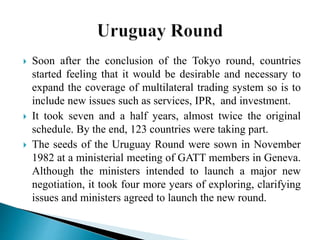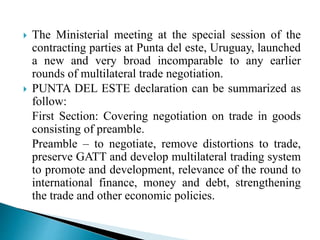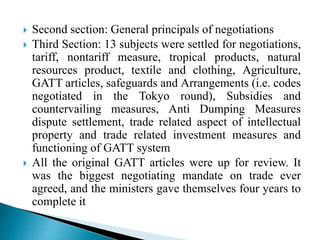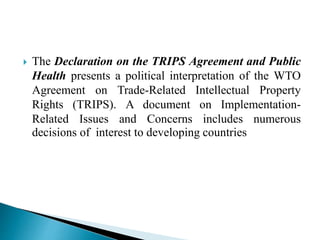Uruguay round and doha round
- 2. Soon after the conclusion of the Tokyo round, countries started feeling that it would be desirable and necessary to expand the coverage of multilateral trading system so is to include new issues such as services, IPR, and investment. It took seven and a half years, almost twice the original schedule. By the end, 123 countries were taking part. The seeds of the Uruguay Round were sown in November 1982 at a ministerial meeting of GATT members in Geneva. Although the ministers intended to launch a major new negotiation, it took four more years of exploring, clarifying issues and ministers agreed to launch the new round.
- 3. During 1982- 1985 GATT Council Held Special meetings to review the understanding regarding Notification, consultation Dispute settlement and Surveillance of Tokyo round In 1985 a preparatory committee for the Uruguay round was established by the contracting parties to determine the objectives, subject matter for the participation of in the upcoming round of multilateral negotiations. Discussed about the agriculture, subsidies, tariffs, dispute settlement, safeguards etc.
- 4. In April 1986- the us representative suggested that there was an urgent need of : 1. To liberalize trade 2. To strengthen the multilateral trading system 3. Need to improve existing GATT Disciplines such as safeguards, agriculture, dispute settlement etc. 4. Expand the scope of the GATT into areas of growing economic concern such as services, intellectual property rights and investment
- 5. The Ministerial meeting at the special session of the contracting parties at Punta del este, Uruguay, launched a new and very broad incomparable to any earlier rounds of multilateral trade negotiation. PUNTA DEL ESTE declaration can be summarized as follow: First Section: Covering negotiation on trade in goods consisting of preamble. Preamble – to negotiate, remove distortions to trade, preserve GATT and develop multilateral trading system to promote and development, relevance of the round to international finance, money and debt, strengthening the trade and other economic policies.
- 6. Second section: General principals of negotiations Third Section: 13 subjects were settled for negotiations, tariff, nontariff measure, tropical products, natural resources product, textile and clothing, Agriculture, GATT articles, safeguards and Arrangements (i.e. codes negotiated in the Tokyo round), Subsidies and countervailing measures, Anti Dumping Measures dispute settlement, trade related aspect of intellectual property and trade related investment measures and functioning of GATT system All the original GATT articles were up for review. It was the biggest negotiating mandate on trade ever agreed, and the ministers gave themselves four years to complete it
- 7. Two years later, in December 1988, ministers met again in Montreal, Canada, for what was supposed to be an assessment of progress at the round’s half-way point. The purpose was to clarify the agenda for the remaining two years, but the talks ended in a deadlock. Despite the difficulty, during the Montreal meeting, ministers did agree a package of early results. Aimed at assisting developing countries as well as a streamlined dispute settlement system, and the Trade Policy Review Mechanism which provided for the first comprehensive, systematic and regular reviews of national trade policies and practices of GATT members.
- 8. The round was supposed to end when ministers met once more in Brussels, in December 1990. But they disagreed on how to reform agricultural trade and decided to extend the talks. The Uruguay Round entered its bleakest period. Despite the poor political outlook, a considerable amount of technical work continued, leading to the first draft of a final legal agreement. This draft “Final Act” was compiled by the GATT director-general, Arthur Dunkel, who chaired the negotiations at officials’ level. It was put on the table in Geneva in December 1991
- 9. In November 1992, the US and EU settled most of their differences on agriculture in a deal known informally as the “Blair House accord”(agreement between the United States and the European Union on export subsidy). By July 1993 the “Quad” (US, EU, Japan and Canada) announced significant progress in negotiations on tariffs and related subjects. It took until 15 December 1993 for every issue to be finally resolved. On 15 April 1994, the deal was signed by ministers from most of the 123 participating governments at a meeting in Marrakesh, Morocco. The WTO replaced GATT as an international organization, but the General Agreement still exists as the WTO’s umbrella treaty for trade in goods, updated as a result of the Uruguay Round negotiations..
- 10. The Doha Round is the latest round of trade negotiations among the WTO membership. Its aim is to achieve major reform of the international trading system through the introduction of lower trade barriers and revised trade rules. The work programme covers about 20 areas of trade. The Round is also known semi-officially as the Doha Development Agenda as a fundamental objective is to improve the trading prospects of developing countries.
- 11. The Round was officially launched at the WTO’s Fourth Ministerial Conference in Doha, Qatar, in November 2001. The Doha Ministerial Declaration provided the mandate for the negotiations, including on agriculture, services and an intellectual property topic, which began earlier. In Doha, ministers also approved a decision on how to address the problems developing countries face in implementing the current WTO agreements.
- 12. There were additional reasons for the negotiations. Just months before the Doha Ministerial, the United States had been attacked by terrorists on September 11, 2001. Some government officials saw the trade negotiations as a means toward that end. Some officials thought that a new round of multilateral trade negotiations could help a world economy weakened by recession and terrorism-related uncertainty. According to the WTO, the year 2001 showed “the lowest growth in output in more than two decades,”
- 13. The Declaration on the TRIPS Agreement and Public Health presents a political interpretation of the WTO Agreement on Trade-Related Intellectual Property Rights (TRIPS). A document on Implementation- Related Issues and Concerns includes numerous decisions of interest to developing countries
- 14. At that meeting, they adopted three documents that provided guidance for future actions. The Ministerial Declaration includes a preamble and a work program for the new round and for other future action. This Declaration folded the ongoing negotiations in agriculture and services into a broader agenda. That agenda includes industrial tariffs, topics of interest to developing countries, changes to WTO rules, and other provisions.
- 15. Thank you















